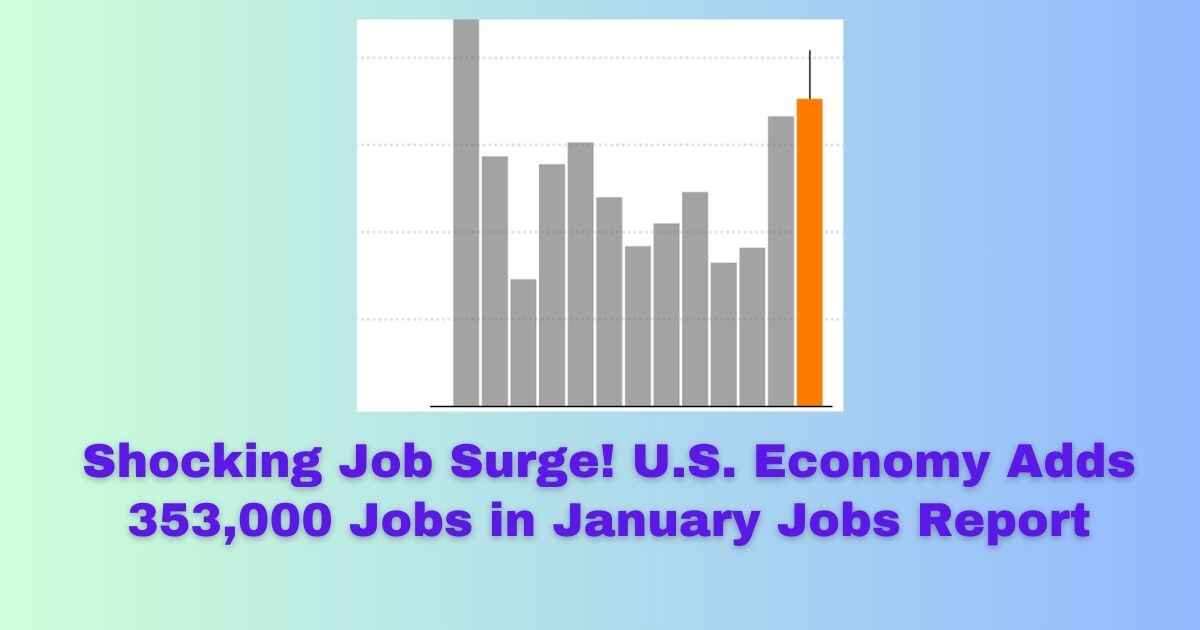The U.S. economy made a remarkable leap in January, adding 353,000 jobs, according to the Bureau of Labor Statistics. This strong gain surpassed expectations, leaving analysts happily surprised. The unemployment rate stayed steady at 3.7%, keeping a trend of 24 straight months with a jobless rate below 4%.
Live Updates: U.S. Economy Adds 353,000 Jobs in January Jobs Report
Page Contents
- 1 Live Updates: U.S. Economy Adds 353,000 Jobs in January Jobs Report
- 2 Which areas added the most jobs in January 2024?
- 3 Which areas lost jobs in January 2024?
- 4 How does this compare to past years?
- 5 What is the Bureau of Labor Statistics?
- 6 What is the Consumer Price Index?
- 7 What is inflation targeting?
- 8 How does this compare to past months?

In comparison to previous months, this rise in job growth suggests a strong start to 2024. Economists had initially projected a net gain of 176,500 jobs for January, but the real numbers far exceeded that estimate. The U.S. economy seems to be on a good track, even as worries about its overall health remain.
While the latest jobs report shows the strength of the economy, it remains to be seen how this data might impact the timing for interest rate cuts. Markets had been looking for rate cuts to begin in March, but Federal Reserve Chair Jerome Powell recently quashed that expectation, saying that there would be no rate cut that month. The strong job numbers from January certainly support this stance.
The U.S. economy kicked off 2024 with a bang, showing strength and growth in the face of economic difficulties. Let’s keep an eye on further changes as the year unfolds.
Which areas added the most jobs in January 2024?
According to the Bureau of Labor Statistics, the US economy added 353,000 non-farm payroll jobs in January 2024, beating estimates of a net gain of 176,500 jobs. The jobless rate stayed at 3.7%.
The following areas added the most jobs in January 2024:
- Health care and social assistance: Added more than 100,000 jobs.
- Professional and business services: Added 7,000 jobs.
- Manufacturing: Added 23,000 jobs.
The ADP National Employment Report also reported that the leisure and restaurant sector added the most jobs in January 2024, with a gain of 28,000 workers.
Which areas lost jobs in January 2024?
In January 2024, several industries suffered job losses in the U.S. economy. Let’s dig into the details:
- Financial Sector: Financial firms reported the biggest number of cuts, with over 23,200 jobs cut. This marks the biggest number of job cuts in the industry since September 2018².
- Tech Industry: The tech industry, which had seen major hiring during the COVID-19 pandemic, faced cuts. In 2023, more than 260,000 tech jobs vanished, and further layoffs were expected. Just in the first 31 days of 2024, 28,970 tech jobs were lost.
- Mining and Logging: Although the sub-category of oil and gas extraction saw a slight gain, the total mining and logging sector lost 7,000 jobs.
- Specific Companies: – UPS: After lower-than-anticipated shipping traffic, UPS cut off 12,000 employees.
- PayPal: Slashed 2,500 jobs due to rising competition from Apple and Zelle.
- American Airlines: Bid goodbye to 656 workers as it combined its customer service area.
- Walgreens: Announced that nearly 150 company employees would be let go to cut costs.
- Tech Layoffs: Altogether, more than 40,000 Americans were put off in January, including tech jobs.
While these cuts are not indicative of a big economic slowdown, they show the challenges faced by businesses. Overhiring and industry-specific reasons led to the job cuts. Let’s keep an eye on further events as the year unfolds¹.
How does this compare to past years?

Certainly! Let’s compare the recent job improvements in January 2024 to earlier years:
- January 2024: – The U.S. economy added an amazing 353,000 jobs.
- Thе unеmploymеnt ratе stayеd stеady at 3.7%.
- Sectors like banking, tech, and mining faced cuts, while the general trend was good.
Previous Years: –
- 2023: The tech business lost over 260,000 jobs, adding to the overall job losses.
- 2022: The economy recovered from pandemic-related problems, with large job gains.
- 2021: The rebound began, but job growth was slower due to pandemic concerns.
- 2020: The COVID-19 outbreak caused huge job losses, leading to a slump.
- 2019: The economy added jobs regularly, with jobless rates falling.
In summary, January 2024 stands out as a strong month for job growth, exceeding predictions. However, it’s important to watch trends throughout the year to understand the wider economic direction.
What is the Bureau of Labor Statistics?
The Bureau of Labor Statistics (BLS) is a government office within the United States Department of Labor. Its main job is to gather and distribute different data linked to the U.S. economy and labor market. As part of the U.S. Federal Statistical System, the BLS offers important information on topics such as employment, unemployment, inflation, productivity, and more.
Here are some key things about the BLS:
- Data Collection: The BLS gets data through polls, studies, and statistical analysis. It makes reports that include important measures like the Consumer Price Index (CPI) and the Producer Price Index (PPI), both of which are significant predictors of inflation².
- Labor Market Insights: BLS records offer insights into employment trends, pay levels, job openings, and separations. For instance, it tracks unemployment rates, payroll employment, and average hourly earnings¹.
- Regional Information: The BLS gives data for individual regions, states, and local places. Researchers, lawmakers, and companies depend on this knowledge to make informed decisions.
- Economic News Releases: The BLS regularly posts economic news releases, which include thorough studies, charts, and data tables. These studies help parties understand the trends of the job market and economic situations.
In summary, the BLS plays a crucial role in forming our understanding of the U.S. economy by giving correct and fast data information. Its studies affect governmental choices, financial markets, and public discourse¹.
What is the Consumer Price Index?
The Consumer Price Index (CPI) is a measure of the average change over time in the prices paid by urban customers for a market mix of consumer goods and services. The CPI is estimated by using a sample mix of items and services. The CPI is widely used as a macroeconomic measure of inflation, as a tool by governments and central banks for inflation targets and watching price stability, and as a deflator in the national accounts. CPI is also used for tracking dearness payments to employees for changes in prices.
What is inflation targeting?
Inflation targeting is a monetary policy approach used by central banks to keep price stability by changing monetary policy to achieve a defined annual rate of inflation. The central bank sets a goal inflation rate and changes its monetary strategy to achieve that rate. The goal rate is generally set at around 2% to 3%. The concept of inflation targeting is based on the view that long-term economic growth is best achieved by keeping price stability, and price stability is achieved by reducing inflation.
Inflation targeting can be compared with other central banks working goals, such as price level targeting and nominal gross domestic product (GDP) targeting. The baseline used for inflation tracking is usually a price index of a group of consumer goods, such as the Consumer Price Index (CPI) or the Personal Consumption Expenditures (PCE) Price Index.
Interest rates can be an intermediate goal that central banks use in inflation planning. The central bank will lower or raise interest rates based on whether it thinks inflation is below or above a goal level. Raising intеrеst ratеs is said to slow inflation and thеrеforе slow еconomic growth. Lowering interest rates is thought to boost inflation and speed up economic growth.
How does this compare to past months?
The U.S. economy made a remarkable leap in January, adding 353,000 jobs, according to the Bureau of Labor Statistics. This strong gain surpassed expectations, leaving analysts happily surprised. The unemployment rate stayed steady at 3.7%, keeping a trend of 24 straight months with a jobless rate below 4%.
In comparison to previous months, this rise in job growth marks a strong start to 2024. Economists had initially projected a net gain of 176,500 jobs for January, but the real numbers far exceeded that estimate. The U.S. economy seems to be on a good track, even as worries about its overall health remain.
While the latest jobs report shows the strength of the economy, it remains to be seen how this data might impact the timing for interest rate cuts. Markets had been looking for rate cuts to begin in March, but Federal Reserve Chair Jerome Powell recently quashed that expectation, saying that there would be no rate cut that month. The strong job numbers from January certainly support this stance.
In summary, the U.S. economy kicked off 2024 with a bang, showing resilience and growth in the face of economic difficulties. Let’s keep an eye on further changes as the year unfolds.
R Amin founded Try Latest Info, a website that provides readers with the latest information on business news, trends, and developments. He shares his insights and expertise through his social media handles and website. To learn more about R Amin or to connect with him on social media, please visit his website at https://trylatestinfo.com/.
